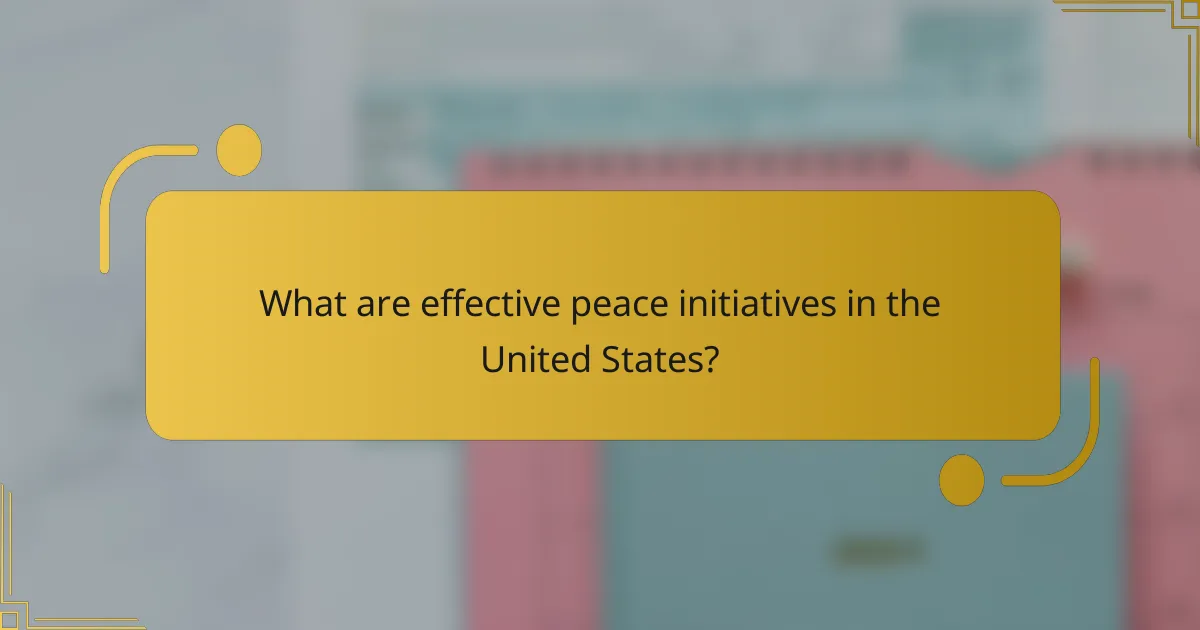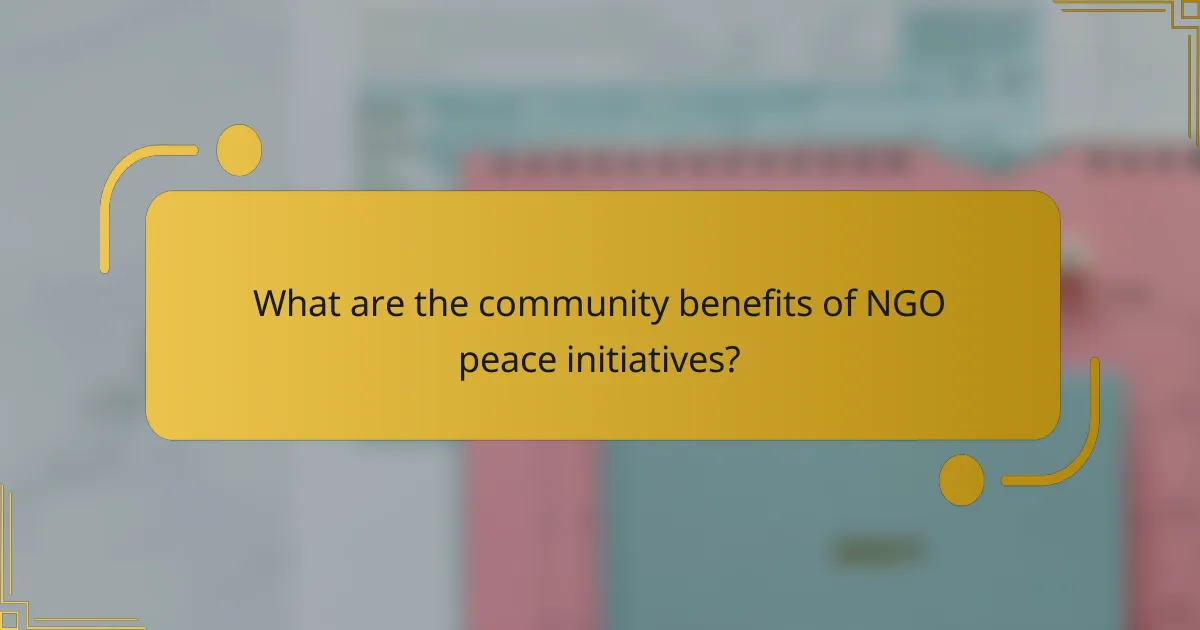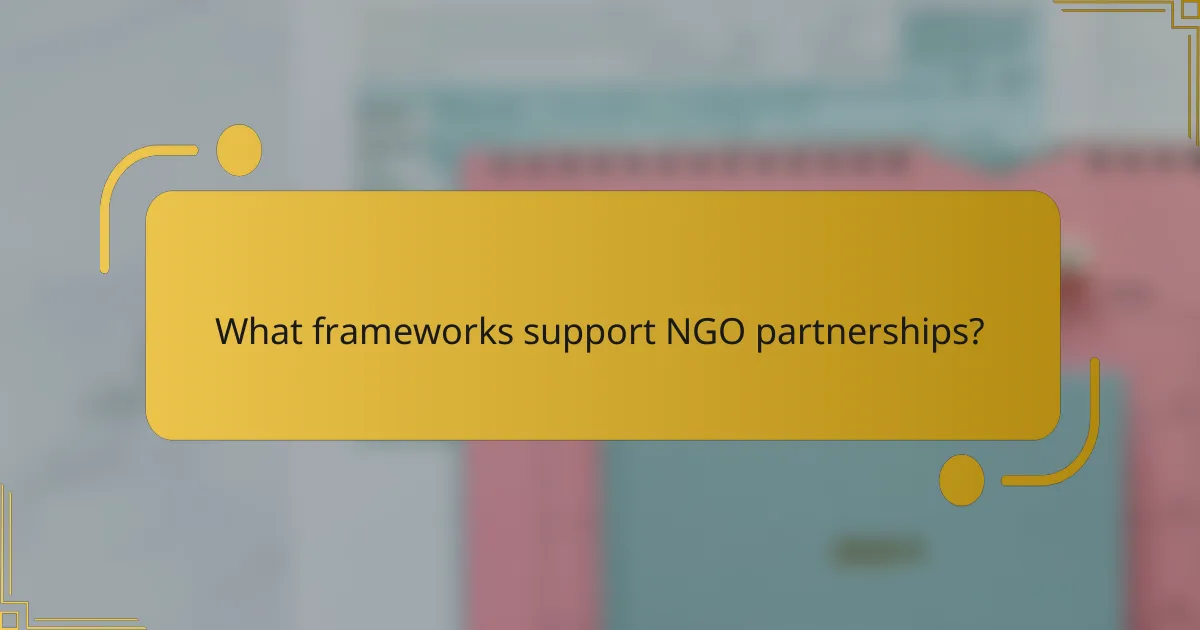Peace initiatives in the United States thrive on the collaboration between communities, NGOs, and stakeholders, aiming to resolve conflicts and promote harmony. By leveraging shared resources and expertise, these organizations implement effective programs that not only address immediate issues but also foster long-term community benefits, such as enhanced social ties and improved safety.

What are effective peace initiatives in the United States?
Effective peace initiatives in the United States focus on collaboration among communities, NGOs, and various stakeholders to address conflicts and promote harmony. These initiatives often involve mediation, education, and advocacy to foster understanding and cooperation among diverse groups.
Community mediation programs
Community mediation programs provide a platform for individuals in conflict to resolve their issues amicably with the help of trained mediators. These programs typically operate at the local level, allowing residents to engage in dialogue and find mutually beneficial solutions without resorting to legal action.
To implement a successful community mediation program, it is essential to recruit skilled mediators and create awareness within the community. Many programs offer free or low-cost services, making them accessible to a wide range of participants.
Conflict resolution workshops
Conflict resolution workshops equip participants with the skills needed to handle disputes effectively. These workshops often focus on communication techniques, active listening, and problem-solving strategies, enabling individuals to navigate conflicts in personal and professional settings.
Organizations can tailor workshops to specific groups, such as schools or workplaces, ensuring relevance and engagement. Regularly scheduled sessions can help reinforce these skills and promote a culture of peace within the community.
Grassroots advocacy campaigns
Grassroots advocacy campaigns mobilize community members to advocate for social change and address systemic issues contributing to conflict. These campaigns often leverage social media and local events to raise awareness and encourage participation.
Successful campaigns typically focus on clear goals, such as policy changes or community support initiatives. Engaging local leaders and influencers can amplify the message and foster a sense of ownership among participants.
Interfaith dialogue initiatives
Interfaith dialogue initiatives bring together individuals from different religious backgrounds to foster understanding and respect. These initiatives often include discussions, shared community service projects, and cultural exchanges that highlight common values and beliefs.
To create impactful interfaith dialogues, organizers should ensure representation from various faiths and create a safe environment for open discussion. Regular meetings can help build relationships and trust among participants, contributing to long-term peace efforts.
Educational outreach programs
Educational outreach programs aim to teach conflict resolution and peacebuilding skills to youth and adults alike. These programs can be integrated into school curricula or offered as community workshops, focusing on topics such as empathy, negotiation, and critical thinking.
Effective educational outreach often involves collaboration with local schools, community centers, and NGOs. Providing resources and training for educators can enhance the impact of these programs, ensuring that peacebuilding skills are passed on to future generations.

How do NGOs collaborate on peace initiatives?
NGOs collaborate on peace initiatives through various strategies that enhance their impact and reach. By pooling resources, expertise, and networks, these organizations can implement more effective programs and foster sustainable peace in communities.
Joint funding applications
Joint funding applications allow NGOs to combine their strengths and present a unified proposal to potential donors. This approach can increase the likelihood of securing financial support, as funders often prefer collaborative efforts that demonstrate a broader impact.
When applying for joint funding, NGOs should clearly outline each organization’s role and the specific outcomes they aim to achieve. Establishing a shared budget and timeline is essential to ensure accountability and transparency throughout the project.
Shared resources and training
Sharing resources and training opportunities helps NGOs maximize their capabilities while minimizing costs. By collaborating on training sessions, organizations can enhance their staff’s skills and knowledge in areas such as conflict resolution, community engagement, and project management.
For example, NGOs can create a shared training calendar that outlines upcoming workshops and resource-sharing initiatives. This not only fosters collaboration but also builds a stronger network among organizations working towards similar goals.
Co-hosted events and workshops
Co-hosting events and workshops enables NGOs to reach larger audiences and create more impactful experiences. By combining efforts, organizations can attract diverse participants and facilitate richer discussions on peacebuilding topics.
When planning co-hosted events, NGOs should establish clear objectives and roles for each organization. This ensures that the event runs smoothly and that all partners are aligned in their messaging and goals.
Cross-organizational partnerships
Cross-organizational partnerships involve NGOs working together on specific projects or initiatives, leveraging each other’s expertise and networks. These collaborations can enhance the effectiveness of peace initiatives by integrating diverse perspectives and resources.
To form successful partnerships, NGOs should identify common goals and complementary strengths. Regular communication and evaluation of the partnership’s progress can help maintain alignment and adapt strategies as needed for optimal impact.

What are the community benefits of NGO peace initiatives?
NGO peace initiatives provide various community benefits, including enhanced social ties, improved safety, and better access to mental health resources. These initiatives foster collaboration and empower individuals, leading to a more resilient and harmonious society.
Improved social cohesion
NGO peace initiatives often focus on building social cohesion by bringing together diverse community members. Through workshops, events, and dialogue sessions, individuals learn to appreciate different perspectives, fostering mutual respect and understanding.
For example, community-building activities such as cultural festivals or joint problem-solving workshops can significantly enhance relationships among residents. This improved social fabric can lead to stronger support networks and a more unified community response to challenges.
Increased public safety
Enhanced public safety is a key benefit of NGO peace initiatives, as they often work to reduce violence and crime through community engagement. By promoting trust between local authorities and residents, these initiatives can create safer environments.
Programs that involve community policing or neighborhood watch schemes, supported by NGOs, can lead to a noticeable decrease in crime rates. When residents feel empowered to participate in their safety, they are more likely to report suspicious activities and collaborate with law enforcement.
Enhanced conflict resolution skills
NGO peace initiatives equip community members with essential conflict resolution skills, enabling them to address disputes constructively. Training sessions often cover negotiation techniques, mediation strategies, and effective communication practices.
By learning these skills, individuals can better manage conflicts before they escalate, fostering a culture of dialogue rather than violence. This proactive approach can lead to long-term peace and stability within communities.
Access to mental health resources
NGO peace initiatives frequently provide access to mental health resources, recognizing the psychological impact of conflict and violence. They may offer counseling services, workshops, and support groups to help individuals cope with trauma.
For instance, partnerships with local mental health professionals can facilitate workshops focused on stress management and emotional resilience. By addressing mental health needs, communities can heal and rebuild stronger relationships, ultimately contributing to a more peaceful environment.

What frameworks support NGO partnerships?
NGO partnerships are often supported by frameworks that emphasize collaboration, shared goals, and resource sharing. These frameworks can enhance the effectiveness of initiatives by fostering trust and aligning the objectives of various organizations.
Collaborative governance models
Collaborative governance models involve multiple stakeholders working together to achieve common goals. These models can include public-private partnerships, where NGOs collaborate with government entities to address social issues. For instance, an NGO focused on education might partner with local schools to improve literacy rates, leveraging resources and expertise from both sides.
Key considerations in collaborative governance include establishing clear roles, responsibilities, and decision-making processes. Effective communication is crucial to ensure that all parties are aligned and that conflicts are managed constructively. Regular meetings and updates can help maintain transparency and accountability.
Network-building strategies
Network-building strategies focus on creating connections among NGOs, community organizations, and other stakeholders. These strategies can enhance resource sharing, knowledge exchange, and collective action. For example, an NGO working on environmental conservation might network with local businesses to promote sustainable practices, benefiting both the environment and the economy.
To build effective networks, NGOs should identify potential partners with complementary missions and values. Engaging in community events, workshops, and online platforms can facilitate relationship-building. It’s important to nurture these connections through ongoing communication and collaboration to maximize the impact of joint initiatives.


